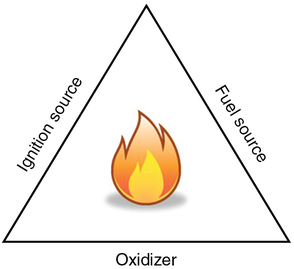Operating room fires
Fire triangle
For a fire to occur, three elements must come together: (1) an oxidizer, (2) fuel, and (3) an ignition source. These three elements are commonly called the “fire triad” and can be represented as a “fire triangle” (Figure 4-1). An OR fire can be prevented by removing any one element of the triangle.
The two oxidizing agents most prevalent in the OR are oxygen (O2) and nitrous oxide (N2O). In the OR, many potential fuel sources are present (Box 4-1). The most common ignition source is diathermy or electrocautery with other ignition sources listed in Box 4-1.






